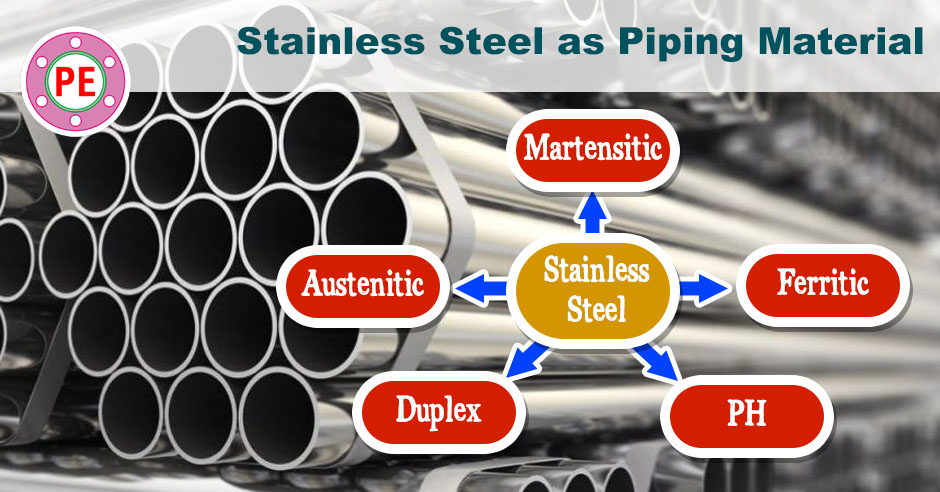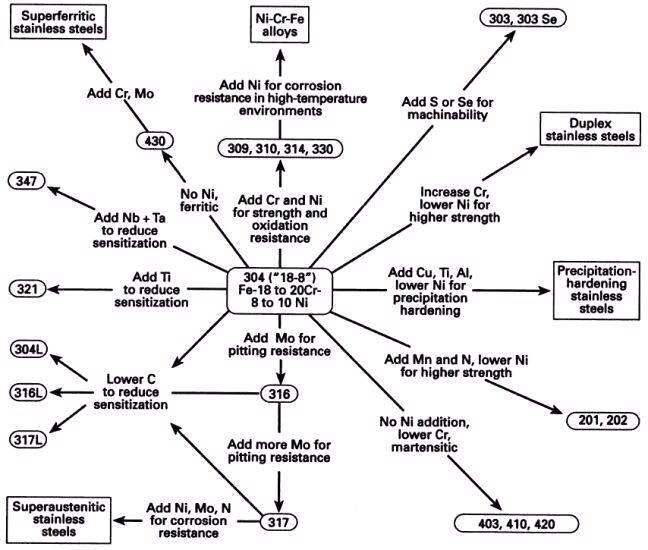Stainless Steel is an alloy steel with chromimum content more than 10.5% and less than 30% and other alloying elements Nickel, Molybdenum etc. Stainless steel exhibits extraordinary corrosion resistance due to formation of a very thin layer of Cr2O3 (Chromium Oxide) on the surface. This layer is also known as passive layer. Increasing the amount of Chromium will further increase the corrosion resistance of the material. In addition to Chromium Nickel and Molybdenum are also added to impart desired (or improved) properties. Stainless steel also contains varying amounts of Carbon, Silicon and Manganese.

Stainless steels are further classified as
- Ferritic Stainless Steels
- Martensitic Stainless Steels
- Austenitic Stainless Steels
- Duplex Stainless Steels
- Precipitation-Hardening (PH) Stainless Steels
[google-square-ad]
Effects of alloying elements in stainless steel
- Nickel in steel increases resistance to mineral acid, produces tightly adhering High temperature oxides.
- Molybdenum in steel increases resistance to chloride (Pitting Corrosion).
- Copper in steel increases resistance to sulphuric acid.
- Titanium in steel stabilize carbides to prevent formation of chromium carbide.
- Niobium in steel stabilize carbides to prevent formation of chromium carbide.
- Lower Carbon content of 304L, 316L and 317L help reduce sensitization.
- Sulfur and Selenium increases machinability of the steel. e.g. 303, 303se
- Lack of nickel in stainless steel makes it magnetic.

Ferritic Stainless Steel
Ferritic steels consists of Iron-Chromium alloys with body-centered cubic crystal structures (BCC). These are generally magnetic and cannot be hardened by heat treatment but can be strengthened by cold working.
[google-square-ad]
Austenitic Stainless Steel
- These are alloys of Cr, Ni, Fe. Example: Type 304, 304L,316,316L.
- It is non-magnetic and non heat-treatable.
- Generally austenitic steels are highly weldable.
- These have Face centered Cubic lattice (fine grain structure).
- They have high Corrosion resistance at temp up to 1500 deg. F.
- They are hardenable by cold woking.
- They possess high impact strength at low temp.
Martensitic Stainless Steel
Martensitic stainless steels are extremely strong and tough but not as corrosion-resistant as the other two classes. These steels are highly machinable, magnetic and heat-treatable.
Duplex Stainless Steels
Duplex stainless steel consists of a two-phase microstructure consisting of grains of ferritic and austenitic stainless steel ( i.e Ferrite + Austenite). Duplex steels are about twice as strong as austenitic or ferritic stainless steels.
Precipitation-Hardening (PH) Stainless Steels:
Precipitation-Hardening (PH) Stainless Steels possess Ultra high strength due to precipitation hardening.
